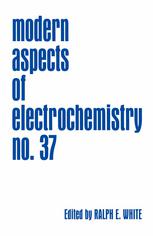

Most ebook files are in PDF format, so you can easily read them using various software such as Foxit Reader or directly on the Google Chrome browser.
Some ebook files are released by publishers in other formats such as .awz, .mobi, .epub, .fb2, etc. You may need to install specific software to read these formats on mobile/PC, such as Calibre.
Please read the tutorial at this link: https://ebookbell.com/faq
We offer FREE conversion to the popular formats you request; however, this may take some time. Therefore, right after payment, please email us, and we will try to provide the service as quickly as possible.
For some exceptional file formats or broken links (if any), please refrain from opening any disputes. Instead, email us first, and we will try to assist within a maximum of 6 hours.
EbookBell Team

0.0
0 reviewsThis volume of Modern Aspects contains seven chapters. The major topics covered in the first six chapters of this volume include fundamentals of solid state electrochemistry; kinetics of electrochemical hydrogen entry into metals and alloys; oxidation of organics; fuel cells; electrode kinetics of trace-anion catalysis; nano structural analysis. The last chapter is a corrected version of chapter four from Volume 35. Faisal M. AI-faqeer and Howard W. Pickering begin the first chapter by going back to 1864 and Cailletet who found that some hydrogen evolved and was absorbed by iron when it was immersed in dilute sulfuric acid. The absorption of hydrogen into metals and alloys can lead to catastrophic failures of structures. They discuss the kinetics of electrochemical hydrogen entry into metals and alloys. In chapter three, Clyde L. Briant reviews the electrochemistry, corrosion and hydrogen embrittlement of unalloyed titanium. He begins by reviewing the basic electrochemistry and general corrosion of titanium. He also discusses pitting and galvanostatic corrosion followed by a review of hydrogen embrittlement emphasizing the formation of hydrides and the effect of these on titanium's mechanical properties. Christos Comninellis and Gy6rgy F6ti discuss the oxidative electrochemical processes of organics in chapter three. They begin by defining direct and indirect electrochemical oxidation of organics. They introduce a model that allows them to distinguish between active (strong) and non-active (weak) anodes. Different classes of organic compounds are used for kinetic models of organic oxidation at active and non-active type anodes.